Using Ballast to Combat Excess Water Retention
My hope is that many of you will bookmark this post and provide a link whenever you come across posts written by others in search of a remedy for problems caused by a saturated medium. As a member of Garden Web/ Houzz who has been assisting members with their container gardening adventures since 2004, I’ve discovered that an extremely high % of the problems growers bump up against are related to excess water retention in the media (soils) they use. The cause of some of these issues, like poor growth and spoiled foliage, are often very apparent. In other cases, where insect infestation and diseases are at issue, the cause might not be isolated as facilely; still, root systems in poor health and with limited ability to function efficiently due to excess water retention in the medium, affect the plant’s metabolism, which in turn affects the effectiveness of the plant’s natural defenses against diseases and insect herbivory. So, where we might be inclined to levy blame for low vitality levels in plants affected by the insects/ diseases we can readily see, in most cases the opposite is true. Low vitality/ weakened plants that result from poor root health, caused by excess water and an insufficient volume of oxygen in the root zone, is the reason underlying most cases of root/foliage diseases and insect predation.
Without question, the best way to resolve problems related to excess water retention is by using a soil that allows you to water correctly. This means using a soil that allows you to water to beyond the point of saturation, so water is draining freely from the drain hole(s) w/o the plant being necessarily punished by a subsequent period of soil saturation that limits root function and damages root health. Understanding what drives water retention in container soils probably represents the largest step forward a container gardener can take at any one point in time. Read more about it here.
Perched water is water that is so tightly held by the force of capillarity it won’t leave the pot, even though the force of gravity is exerting its downward pull. Capillarity is the sum of the forces of cohesion and adhesion and what causes sponges to be moist, even after we thoroughly wring them out. Cohesion causes water molecules to stick to other water molecules, which is why water forms drops. Adhesion causes water to stick to dissimilar molecules, like those in soil particles and pot walls, and is the reason that drops of water can be observed adhering to even perfectly vertical surfaces. Acting together, the cohesive and adhesive forces in container media are regularly observed to be stronger than gravity, thus preventing water from moving downward and out of media through the drain hole(s) that should be a part of every conventional container planting. When capillary attraction is stronger than gravity, water ‘perches in the soil above the container’s bottom. Since it is primarily the saturated fraction of the medium that acts to limit root health/ function, anything we can do to reduce the amount of saturated soil in a container, the less potential soil saturation has to limit root health/ function.
To the point of this post, which focuses on how to use ballast to limit the volume of soil in any container that is capable of holding perched water. First, though, it is important to note that the amount of perched water a soil can hold varies from one soil to another and by container size shape; BUT, the height of the perched water table supported by any given soil will be the same in any container size/shape used. That MG Moisture Control Soil you might use, the one that supports 6” of saturation at the bottom of the pot? No matter what the size or shape of the container, when the soil is saturated, it will always support 6” of saturation, i.e. until that ht. is reduced by way of evaporation or evapotranspiration.
If we use a “drainage layer” of stones/ gravel/ packing peanuts …, it doesn’t increase drainage. E.g., if we have a pot that is 12” deep and a soil that supports 6” of perched water at the bottom of the pot, adding a “drainage layer” simply causes water to perch to a ht of 6” above the drainage layer. Whereas the max height of the drainage layer would be 6” from the container’s bottom w/o a drainage layer, adding a 3” “drainage layer”would cause water to perch above that to a ht of 9”, which is actually an effort that ends up being self-defeating.
Let’s use our mind’s eye for a moment to visualize what using ballast can do for us in terms of reducing retention of unwanted or excess water. We already learned that the potential ht of a perched water table remains constant for any given soil. For this visualization, we will use a soil that supports 4” of perched water/ soggy soil. Let’s also imagine that our container is 9x9x10” deep. The potential volume of soil saturated with perched water is equal to 9x9x4, or 324 cubic inches. But what happens if you place a 4x4x8” brick in the bottom of the pot as ballast before you fill it? The brick takes up 128 cubic inches of space that would otherwise be occupied by saturated soil. Let’s add 2 bricks, so the amount of soil that can hold perched water is reduced from the 324 cubic inches w/o the 2 bricks as ballast, to only 68 cubic inches, with ballast - less than 1/5 the amount before adding ballast. With a little planning, you can reduce the volume to less than 10% of the amount of soil saturated before adding ballast, which goes a very long way toward providing a remedy for woes related to saturated soils.
One very important consideration relates to the fact that there must be a continual soil column that extends from the top of the soil to the bottom of the pot. If you had an 8x8x12” pot and were using a soil that supports 4” of perched water, adding 2 – 4x4x8 bricks would fill the bottom of the pot, which would cause water to perch 4” above the bricks; but, if there was a small crack between the bricks that allowed an unbroken soil column from the soil mass above the bricks to the bottom of the pot, the only perched water in the entire configuration would reside in the soil occupying the small space between the bricks.
In addition to using ballast, there are other tricks that employ some simple science that allow you to reduce the amount of water a given soil can hold. You can read more about them here. You can read more about them here.
The first link I left, at the end of the second paragraph above, explains a concept that makes growing proficiently much easier on multiple fronts. I highly recommend you take the time to become familiar with it to the degree that by default, it's part of the compendium of container gardening knowledge you can apply at will. When you understand and put the concept it explains to work, using ballast won't be necessary.
If you think it might be helpful, I can provide a few sketches I drew that should help to clarify some of the info provided.
Take care.
Al
Comments (21)
Ekor Tupai
6 years agoThe bottleneck of water movement in pot isn't on vertical movement, but horizontal movement. When you're using ballast, you practically remove the bottleneck. With ballast, you're only dealing with vertical movement because on bottom of the pot, water flow freely horizontally toward the pot hole. Same argument apllied that 5 holes on bottom of the pot is better than only 1. Both have same functionality, avoid long distance horizontal movement. Perched water is horizontal movement problem. It won't happen in ground where water able to go vertically down freely, without necessity to move horizontally.
Related Professionals
Chattanooga Landscape Architects & Landscape Designers · Wixom Landscape Architects & Landscape Designers · Mooresville Landscape Contractors · Bergenfield Landscape Contractors · Brockton Landscape Contractors · Burien Landscape Contractors · Centereach Landscape Contractors · Eureka Landscape Contractors · Fort Wayne Landscape Contractors · Goodlettsville Landscape Contractors · Streamwood Landscape Contractors · Winchester Landscape Contractors · Markham Landscape Contractors · Maplewood Landscape Contractors · Aspen Hill Interior Designers & Decorators- tapla (mid-Michigan, USDA z5b-6a) thanked tropicofcancer (6b SW-PA)
tapla (mid-Michigan, USDA z5b-6a)
Original Author6 years agolast modified: 6 years agoGudang - I didn't write this so I could argue minutia with you and correct misinformation. I wrote it so those who might wish to incorporate the use of ballast into their care regimen as a strategy to eliminate some of the destructive effects of overly water-retentive soils had a place to ask questions.
A) Perched water (PW) is a horizontal AND vertical problem. Since the amount of PW any given soil will hold is primarily driven by soil particle size, and as the size of soil particles comprising a soil decrease in size, the height of the perched water table (PWT) at container capacity increases - a vertical issue. Container capacity is the state of the soil's water-holding ability at the point in time when the container has just stopped draining after being totally saturated. In soils that hold perched water, this is the point in time at which the PWT will be at its maximum height.
B) In any soil that supports PW, the height of the PWT at container capacity is consistent (all else being equal, like altitude, temperature), and the height of the PWT remains the same regardless of container size or shape. So at container capacity, the the PWT will occupy all containers to a consistent ht (for a given soil) and will occupy all pore space from container wall to container wall. So PWTs have inherently horizontal considerations as well.
The image below illustrates how water moves both vertically AND horizontally, even when applied to a surface area only a few millimeters square. If the experiment below was repeated, with the only variable being the water was spread evenly over the top of the surface with a rose on a watering can, the upper layer would be entirely saturated, and remain so, until the gravitational flow potential (weight) of the water in the PWT became greater that the sum of the forces of cohesion (water's tendency to stick to itself) and adhesion (water's tendency to adhere to soil particles and pot walls).

AlEkor Tupai
6 years agolast modified: 6 years agoAs you see on images above, adhesion/cohesion controling the flow because the soil is dry, so water spread almost evenly in any direction. Even if the water comes from bottom, the flow pattern will be almost identical.
On pic above, if water from the top continuously flowing till the pot full of water, the drying process will be like what i wrote above. Soil surface that contact with free air is the key on removing water that trapped on perched water zone. Larger the size, quicker they go away. Water in that zone not stay there forever.
tropicofcancer (6b SW-PA)
6 years agoGudang: you completely missed the point in the picture above. Notice how water the two layers of soil of different composition behave differently? Your answer has no relationship to the pictures posted above.
tapla (mid-Michigan, USDA z5b-6a) thanked tropicofcancer (6b SW-PA)Ekor Tupai
6 years agolast modified: 6 years agoI know. That's the pattern of water when entering dry soil. Infiltration, the movement of water because adhesion/cohesion, will refuse to flow from smaller soil particle to bigger soil particle till the smaller soil particle become saturated. But when all the soil completely saturated with water, Infiltration no longer control the process. Gravity and surface where water able to exit/evaporate work dominantly on removing water from the soil which is called water redistribution, a draining process. On some circumtances, the surface area become so high (pot that have so many holes) making evaporation rate higher than water movement speed through the soil, that make perched water impossible to be exist. I'm not talking how water entering the soil, i'm talking the draining process/removing water from soil.
somegu7
5 years agolast modified: 5 years agoWhat material you recommend for the ballast "brick", if that changes something?
Also what position of the brick is the best for the root development? (Sorry for bad drawing)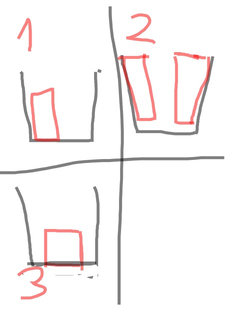
tapla (mid-Michigan, USDA z5b-6a)
Original Author5 years agoEvery soil that supports a perched water table (PWT) will support the same amount of perched water (PW) in containers of all shapes/sizes, as long as the container isn't shallower that the ht of the PWT.
Let's say you choose a soil that holds 4" of perched water. You can eliminate almost ALL of the PWT a planting can hold by NEARLY filling the entire bottom 4" of the pot with ballast. The key is, you MUST leave a continuous column of soil that reaches to the bottom of the pot. If you have a pot with an ID of 8 x 8, 2 bricks that are 4x4x8 will fill the entire pot, and water will perch above the bricks; but, if the bricks were only 7" long, you would have 2 - 1x4x4" columns of soil through which the perched water could drain. Essentially, the ONLY soil that could hold perched water is that soil occupying the space not taken up by the 7" bricks. So, instead of having a maximum of 256 cu " of soil holding PW, you would only have 1x4x4x2 cu in, which equals 32 cu in. That's a huge difference.
Another way of looking at it is, after you arrange the ballast in the bottom of the pot, you should be able to see the pot bottom through the spaces between the pieces of ballast. This is what allows water to move downward, pushed by the weight of the water above.

The owner of UpsaDaisy asked me to try his pot inserts, then sent me a whole case of inserts of all sizes to try. I explained to him why they were actually going to be a hindrance, because water was going to perch above the insert (even with the holes in it), and its effect would be only to reduce the amount of soil the pot could hold. He wanted me to do the trial anyway, so I planted cherry tomatoes in the pots. The ones in the UpsaDaisy pots fared nowhere near as well as the pots that were filled with soi. IF there was a tube you could push through say a 1.5" hole in the insert so it went all the way to the bottom of the pot, such that the tube filled with soil when you filled the pot, it would work like a champ, though you'd need to use a larger pot than normal to make up for the reduced soil volume.
Images that might help:PWT same ht in all pots:

An overturned pot (see D) can be used as ballast. Note how it reduces the amount of soil that can hold PW:
Below, notice the PWT is the same Ht in all 3 pots, and how water perches above a drainage layer of coarse material. Envision the bricks in the right image as being turned on edge, and 2 more added. Can you see how little soil would be capable of holding PW?
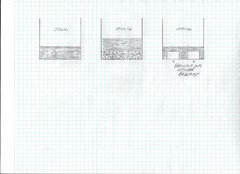
AlEkor Tupai
5 years agoThe last pic is incorect. The height of perched water table should be count from unpenetrable layer, which is the bottom of the pot, not from the upper level of the ballast. If you give brick above the bottom of the pot, soil PWT will be significantly reduced. Just googling it.
tropicofcancer (6b SW-PA)
5 years agoAll pictures are correct. And can you be more specific - which one in the last picture, left, middle or right? You may get a slight bump upwards of PWT over the bricks but in container dimensions it will be negligible. In large (earth) scales it will be a different matter.
Ekor Tupai
5 years agoLast, middle. Physical laws work same way in ground or in pot. There will be PWT in ground if there's unpenetrable layer that prevent water flow downward. On soil particles that already wet, you can't expect water move as if it flow on dry soil.
Look on water movement on dry soil above. You'll see that gravity almost have no impact. On dry soil, small soil particle is easier to break water tension (like needle break a baloon) that make the adhesion work later on, covering particles with water.. and cohesion make the water flows filling up gap between particles, push gas away. Water move almost identical to any direction. Water won't flow to bigger soil particles before smaller soil particles become saturated or too heavy that gravity start do it's job pull water down.
When all particles already wet, water will move differently. No need to break a baloon. Gravity pull water down, and cohesion will make it flow, drag upper water down because water won't leaving space with zero pressure between them. Gravity no longer work when water hit unpenetrable surface, there you get PWT, where water unable to move down..
tropicofcancer (6b SW-PA)
5 years agolast modified: 5 years agoPerched Water Table (PWT) is by definition has to do with gravity. Gravity is supposed to pull everything down and yet you find saturated layer of soil in containers and on certain geological formations on earth. That saturated layer of soil that seemingly defies gravity is PWT.
There does not need to have a impenetrable layer to have a PWT. Take a very wet sponge and let it drain and then hang it in air. There will still be substantial water in the sponge that you can squeeze out. That water is held in there by capillary forces and gravity cannot overcome it. Same happens when there is a coarse layer of soil below finer layer of soil. The coarse layer has much less capillary force compared to the finer layer and thus the finer layer holds on to the water - just like the sponge in air.
Gravity always has an impact. The capillary forces are also powerful. The height of PWT determined by both when they cancel each other out. Finer the soil, smaller is the air space and higher is the capillary force pulling water along the surface of the particle.
Capillary force depends on the size of the air space. Size of the particle is incidental here. You can get the same effect using a very fine glass tube. If you dip one end in water the water will rise up through the tube because of capillary action. Finer the tube's inner diameter the larger is the upward force.
Your balloon example is also incorrect. Try to wet very fine dry peat moss and you will be frustrated. On the other hand once it gets a little wet it can absorb lot more water. Hydrophobicity occurs with some types of particles such as peat moss because the adhesive force between water and the particle is much weaker than the cohesive force between water molecules. In case of peat moss, the adhesive force is very low when dry but increases tremendously once slightly wet.
Ekor Tupai
5 years agolast modified: 5 years agoYour sponge example isn't PWT, you hang your clothes to dry isn't PWT.. etc. PWT happened when condition force water to move sideways only because it get difficulty on moving down (both by gravity or capillary force)
When you dip clotes to water, they will wet, water climb up. Then try hang them. Water will flowing down, and eventually gone. Soil is like clothes, not a perfect tubular shape. Give ballast is like hanging the soil. Gravity and capillary force isn't against each other. Capillary force isn't force water up only. It force water move anywhere to dryer locations, include to ballast area where air make that location dryer.
You should compare apple to apple, not apple to mango. Try to make different particle size of peat moss. Water will spread, filling up smaller particle first and move to bigger particle later. Avoid "too fine" particle size as an example, since it will become unpenetrable, like very fine clay, peat, or such thing. Those materials isn't for planting, better use them to make roof.
Ekor Tupai
5 years agoOne more thing. Peat moss isn't hydrophobic, nor adhesive weaker than cohesive. It's perfectly wet-able. The cause dry materials hard at first to be watered is their high gas content in it's individual material pores. Dry mean their pores full of gas. And pores not always tubular with 2 way in out. Some only have single hole, like bottle. 1 way out. Hydrophobic is term used to explain materials that have different polarity so it's not wet-able by water. Like oil, wax.. for example.
To explain adhesive weaker than cohesive, try split mercury on floor. It will be like small ball. Not make the floor wet. Or look the rainfall.. every drop of water explain cohesion stronger than adhesion..
tropicofcancer (6b SW-PA)
5 years agoFrom my perspective, I think it is best not to pursue this debate any further.
Ekor Tupai
5 years agolast modified: 5 years agoYup. It's always better try yourself using glass/transparent pot to see how water moving out of the pot rather than debating. Pot made from mineral water bottle is ok for experiment.
tapla (mid-Michigan, USDA z5b-6a)
Original Author5 years agolast modified: 5 years agoThe last picture is not incorrect, there is no ballast in the pot. Ballast is different and behaves much differently than a drainage layer, which is how I identified the material in the pot bottom. This means it id greater than 2.1x the size of the material above the drainage layer in order for my point to be correct. If I meant it to be 'ballast', I would have named it ballast. This is getting wearisome. You aren't contributing anything to the conversation that could be considered useful or practical to the average reader; instead, you seem intent on starting debates re insignificant things that go nowhere. ..... and a sponge can be used to almost almost perfectly exemplify how the forces of adhesion and cohesion act in concert to support perched water; so can a simple insect screen.
When water hits an impenetrable surface, it doesn't "perch". Instead, the impenetrable surface impedes percolation. Water doesn't really perch above clay, percolation into/through the clay stops or slows dramatically - there is a very large difference between perching and water impeded by an impenetrable layer of clay. Water only 'perches' in strata of fine materials above another strata of materials at least 2.1x larger than the finer material.
An impenetrable surface, if pot walls are high and strong enough, can support a water column hundreds or even thousands of meters tall. Whereas, a soil that supports a 4" perched water column, all else equal, will only support a 4" water column in any pot with a drain hole. A pot bottom is not an impenetrable surface unless it has no drain holes.
Al
Ekor Tupai
5 years agolast modified: 5 years agoSponge will retain water if you put it on unpenetrable surface. If you hang it, the water will gone much faster, except for sponge that created specifically to absorb water. Kind of sponge that you have to squeeze it to make water in, and also need to squeeze it to make water out. It work mainly caused by your energy that push gas out and create vacuum condition inside.
Pot is penetrable layer if have NO bottom. Longer the distance that make water have to travel horizontally, higher the PWT. More holes, less PWT. Same soil, it hold 4 inch or 4 foot height PWT is depend on the distance water have to travel horizontally. In ground, people mistakenly making well above water table, thinking it's an underground water source because the PWT can be so high.
I'm still in topic btw.. , my opinion is contribution to the topic, to this site, to the readers. Not for you or your idea probably. Now look at you that judging me. Do ad hominem to me. Are you god? Mr absolut correct? Is it so hard to keep in topic without insult personal opinion?
Btw.. nevermind. Insult me, i'm tough.
HU-43480125137
5 years agoHelp me with this, neon pathos turnign yeloow
https://www.gardenweb.com/discussions/5350305/neon-pathos-turning-yellow-and-brownEkor Tupai
5 years agoIf you see water trapped in the middle of a straw or anywhere else, that is not a PWT. PWT always related to unpenetrable layer underneath, not the substance or materials holder. Water that trapped because adhesion/cohesion can be exist anywhere, but that not always mean gas unable to circulate around as if it's PWT.
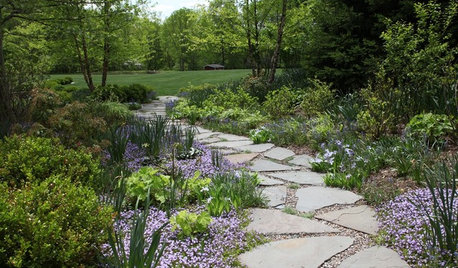

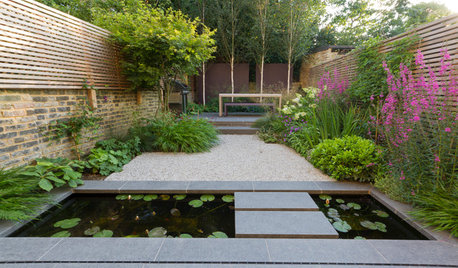



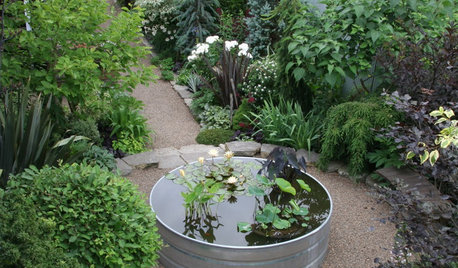













User